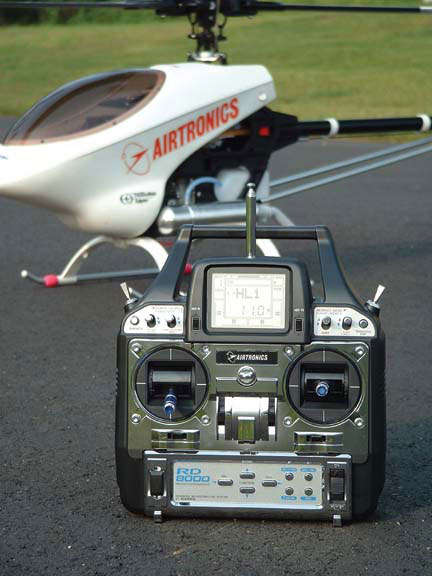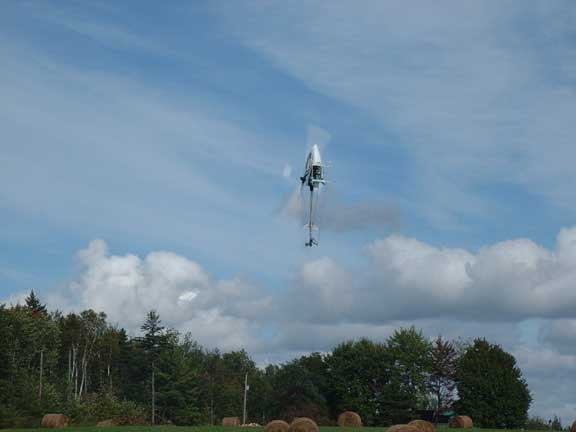

SUBSCRIBE TO ROTORY ROTORY BACK ISSUES DOWNLOAD THIS ISSUE TO YOUR COMPUTER
 |
|
For more than ten years, I have always been an admirer of German engineered Vario scale helicopters. Vario helicopters have different engineering features when compared to other German, Asian, and American designed model helicopters. Vario designers experiment with something radical on every new model that they create, and each model demonstrates a different outside-the-box thinking. For example, the Vario Viper has its swashplate located below the rotor shaft bearing block, and has a 540cc tank behind the main shaft and a second 400cc tank in front of the main shaft. Regardless of whether people like it or not, there is no other R/C helicopter in the world like the Viper. The Vario Extreme uses an aluminum bulkhead instead of flat plate sideframes, and it uses a toothed belt transmission to reduce helicopter noise, and offers a choice of either clockwise or counter-clockwise rotation main rotor. The Skyfox Series is a refinement on the classic Heim mechanics, but with 120-degree electronic CCPM (Cyclic-Collective Pitch Mixing) control and a three-bladed cooling fan underneath the engine to draw air around the engine for cooling. The Benzin Trainer is the most popular gasoline engine powered helicopter in Europe and more have probably been sold than any other gas helicopter in the world. The new Benzin Acrobat, introduced in 2003, is formulated for 3-D enthusiasts. The Boxer is a big aerobatic helicopter, powered by a twin-cylinder OS 160 four-stroke engine, and employs two exhaust pipes to create a quiet and unique sound in flight. The Boxer and Xtreme were popular in the German Poting Cup 3-D contest because bonus points were awarded for quietness. The Silence is a big electric helicopter powered by 30-cells and a Kontronik brushless motor. |
 |
|
In 2003, Airtronics introduced a new radio
called the RD8000, which is a more powerful eight-channel version
of their popular six-channel RD6000 Super. The RD8000 system,
with receiver and servos, is available as a helicopter or an
airplane system. The only differences between the airplane and
the helicopter systems are the servos and the receiver NiCd battery
size. The helicopter system comes with five ball bearing supported
94731Z or 94322Z servos that are suitable for heli use, and an
1100 mAh receiver NiCd battery. The heli system with five 94322Z
servos is priced less than the heli system with five 94731Z servos.
The 94322Z servo is for 30 to 50-size helicopters. The 94322Z
has 50 in-oz of torque and a travel speed of 0.20 second per
60 degrees at 4.8 volts. The higher torque, double ball bearing
94731Z servo utilizes a coreless motor and offers performance
comparable to Futaba 9202 and JR 4131 servos, but the 94731Z
has an excellent gear mesh. All Airtronics servos now come with
a blue color Z-style connector that is 100% compatible with JR,
Futaba, and Hitec receivers and servos. |
 |
|
Everyone agrees that lighter aircraft fly
better than heavier ones with the same power plant. This is very
important with electric helis, "E-Helis". To remove
some weight that will not make the heli any less durable, I did
the following. First off, I removed more of the stock canopy
area by adding extra holes to save weight; which in turn delivers
more performance and little increases in flight duration, since
the heli isn't dragging around extra ballast weight. Within the
past year, I have come up with an aftermarket clear paintable
canopy for the VoyagerE that resembles the JR Vigor silhouette.
It fits right onto the stock canopy mounts of the heli and fits
both stock framed and carbon framed VoyagerE helis. We have found
that even with multiple colors and decal schemes that it weighs
less than the stock canopy trimmed out for weight. In addition,
I personally feel it looks 100% better as well. |
 |
|
At first site, the visuals of the new Thunder Tiger Raptor 90 is not a retina detaching experience. Appearance-wise, it looks like that of the standard Raptor 60 machine, however, that's where it stops. On the inside, the Raptor 90 production kit is a re-engineered platform, capable of supporting the larger .90 class engine. On the design end of things, the R-90 uses many of the traits of the past R-60 V2, except it's now beefy, improved, and a bit larger. The Raptor 90 kit is not for the weak and
timid. With its "big block" 90-engine, the kit falls
into the category of a rocket ship with rotor blades. For those
who have not flown a 90-helicopter before, the best way I can
describe it is you can do whatever you like and never worry about
much of anything. That is, except hitting the ground. Because
of the R90's power-to-weight, you'll seldom do anything cyclic
or collective-wise to "get into the engine." |
 |
|
The rotor tach has been a standard on full-size
helicopters since the early days due to the critical nature of
maintaining exacting rpm (rotations per minute). The main reason
is that structural limitations might be exceeded either by an
excessively low or high rotor rpm (+/-15%). For the most part,
models have the advantage of totally ignoring this parameter.
There are issues we share with our bigger brethren, one of which
is efficiency and another of cyclic response. A faster turning
rotor will produce a more aggressive cyclic control and at the
same time store more energy. The latter may be used to fly the
machine through temporary situations, demanding a momentary spike
in unavailable engine power. This is sometimes the case with
the smaller models when pushed to the limits. |
SUBSCRIBE TO ROTORY ROTORY BACK ISSUES DOWNLOAD THIS ISSUE TO YOUR COMPUTER